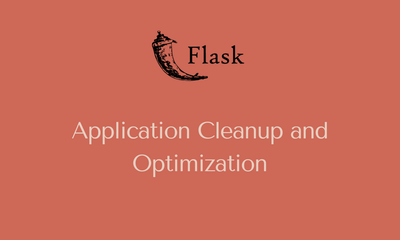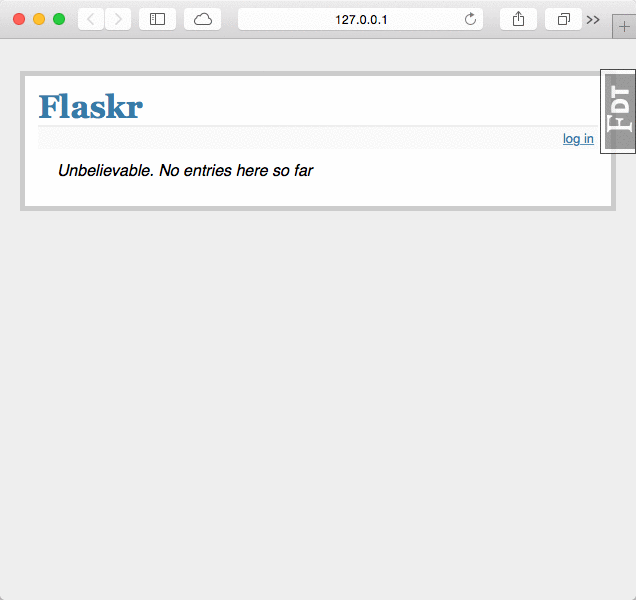Flaskアプリケーションのクリーンアップと最適化
By khoanc, at: 2023年8月15日11:05
Estimated Reading Time: __READING_TIME__ minutes


Flaskアプリケーションのクリーンアップと最適化の世界へようこそ!Flask
このガイドでは、Flaskアプリケーションをスムーズに、効率的に、不要なクラッターから解放して実行するための重要な実践方法を探ります。最適化されたFlaskアプリケーションは、優れたユーザーエクスペリエンスを提供するだけでなく、コードベースの保守性とスケーラビリティも確保します。それでは、Flaskアプリケーションのクリーンアップと最適化のための最良の戦略を探っていきましょう。
1. Flaskアプリケーションクリーンアップの理解
Flaskアプリケーションがリクエストを処理すると、メモリにさまざまなオブジェクトとリソースが作成されます。これらのリソースが適切に管理されず、クリーンアップされないまま時間が経過すると、メモリリーク、パフォーマンスの低下、さらにはアプリケーションクラッシュにつながる可能性があります。アプリケーションの健全性と寿命を維持するには、適切なクリーンアップが不可欠です。
便利なパッケージ:
2. クリーンアップが必要な一般的な領域
Flaskアプリケーションには、適切なクリーンアップが必要ないくつかの領域があります。
2.1 データベース接続
データベースとやり取りする際には、データベース接続が不要になったらすぐに閉じる必要があります。そうしないと、使用されていない接続のプールが作成され、最終的にリソース枯渇につながる可能性があります。
Flaskデータベース管理には、Flask-SQLAlchemyとFlask-Migrateの2つの一般的なパッケージがあります。どちらもうまく機能し、データベース接続管理をサポートしています。
2.2 ファイル処理
ファイルを適切に閉じずに開くと、ファイル記述子リークが発生する可能性があります。これらのリークを防ぐために、コンテキストマネージャーを使用してファイルを必ず閉じます。これは、Pythonのwith文を使用して簡単に修正できます。
# これは良くありません my_file = open("hello.txt", "r") print(my_file.read())# これははるかに優れていますwith open("hello.txt", "w") as my_file: my_file.write("Hello world \n") my_file.write("I hope you're doing well today \n") my_file.write("This is a text file \n") my_file.write("Have a nice time \n")
2.3 サードパーティAPI呼び出し
Flaskアプリが外部APIとやり取りする場合は、不要なリソースの消費を避けるために、各API呼び出し後に接続を閉じ、リソースを解放してください。
StackOverflowには、API呼び出しによって発生するFlaskアプリのメモリリークに関するよくある質問もあります。
2.4 低速トランザクション
Flaskアプリケーションが時間の経過とともに悪化する理由はたくさんあります。
- 速く動いて壊れる
- 人的リソースが限られている
- 予算が厳しい
- 厳しい締め切り
これは、貧弱/雑然としたソースコードと低いパフォーマンス品質につながります。
3. メモリ管理とガベージコレクション
Flaskの基盤となる言語であるPythonは、ガベージコレクションメカニズムを使用して、参照されなくなったオブジェクトが占有するメモリを自動的に解放します。これがどのように機能するかを理解することで、Flaskアプリでのメモリ使用量を最適化できます。
詳細についてはこちらを参照してください。簡単に言うと、Pythonはメモリ管理のエキスパートではありませんが、バックグラウンドですべてをサポートしているので、心配する必要はありません。
4. Flaskアプリケーションクリーンアップのベストプラクティス
Flaskアプリケーションを整理して最適化するには、次のベストプラクティスに従ってください。
4.1 コンテキストマネージャーを使用したデータベース接続のクローズ
@app.teardown_appcontext
def close_db(error):
if hasattr(g, 'db'):
g.db.close()
これは、Flask-SQLAlchemyパッケージを使用して簡単に実行できます
4.2 ファイルハンドルの解放
with open('file.txt', 'r') as file:
content = file.read() # ブロックが終了するとファイルは自動的に閉じられます。
4.3 atexitモジュールの活用
import atexit
def cleanup():
# クリーンアップタスクを実行します
atexit.register(cleanup)
4.4 カスタムクリーンアップデコレーターの実装
def cleanup_resources(f):
def wrapper(*args, **kwargs):
result = f(*args, **kwargs) # クリーンアップタスクを実行します resultを返します
return wrapper
4.5 環境と設定のセットアップのリファクタリング
アプリケーションが成長するにつれて、多くの環境変数と設定が存在し、アプリケーションの設定と制御が雑然としたものになります。Python-dotenvパッケージのおかげで、アプリケーション環境設定は簡単に管理され、クリーンになります。
5. ルートハンドラの最適化
ルートハンドラーはFlaskアプリケーションの中核です。最適なパフォーマンスを確保するには、次のヒントを検討してください。
5.1 不要な計算の最小化
ルートハンドラー内で冗長な計算を避けてください。可能であれば、コストのかかる計算の結果をキャッシュします。
@app.route("/")
@cache.cached(timeout=50)
def index():
return json.dumps({"a big dictionary": "value"})
5.2 頻繁にアクセスされるデータのキャッシングを活用する
Flask-Cachingのようなキャッシュライブラリを使用して、頻繁にアクセスされるデータを保存および取得し、アプリケーションの負荷を軽減します。
@cache.cached(timeout=50, key_prefix='all_comments')
def get_all_comments():
comments = do_serious_dbio()
return [x.author for x in comments]
cached_comments = get_all_comments()

6. 効率的なテンプレートレンダリング
効率的なテンプレートレンダリングは、アプリの最適化において重要な役割を果たします。
6.1 テンプレート継承の使用
テンプレート継承を利用して、コードベースをDRY(Don't Repeat Yourself)に保ち、簡単に保守できるようにします。
子テンプレートは次のようになります
{% extends "base.html" %}
{% block title %}Index{% endblock %}
{% block head %}
{{ super() }}
{% endblock %}
{% block content %}
6.2 レンダリングされたテンプレートのキャッシュ
同じコンテンツを繰り返しレンダリングするオーバーヘッドを削減するために、レンダリングされたテンプレートをキャッシュします。詳細については、こちらをご覧ください
7. 静的ファイルの処理
ほとんどの場合、静的ファイルはstaticディレクトリ/フォルダに配置されるように設定されています。これは、現在のアプリケーションで過負荷になり、大量のデータ転送を消費することになります。これは、Flask-S3パッケージを使用することで回避/最小化できます。
静的ファイルを効率的に処理することで、ユーザーエクスペリエンスが向上します。
7.1 ブラウザキャッシングの実装
適切なキャッシュヘッダーを設定して、ブラウザがCSS、JavaScript、画像などの静的アセットをキャッシュできるようにします。
7.2 コンテンツ配信ネットワーク(CDN)の使用
特にグローバルユーザーの場合、読み込み時間を短縮するために、静的ファイルの配信をCDNにオフロードします。これは、Cloudflareサービスを使用して簡単に設定できます。
8. Gunicornの設定
Pythonアプリを実行するための一般的なHTTPサーバーであるGunicornを最適化して、パフォーマンスを向上させます。
8.1 ワーカープロセスとスレッドの設定
サーバーのリソースと予想される負荷に基づいて、ワーカーのプロセスとスレッドの数を調整します。
8.2 ワーカータイムアウトの管理
プロセスがスタックしてボトルネックを引き起こすのを防ぐために、ワーカータイムアウトを設定します。
NUM_WORKERS=3
TIMEOUT=120
exec gunicorn ${DJANGO_WSGI_MODULE}:application \
--name $NAME \
--workers $NUM_WORKERS \
--timeout $TIMEOUT \
--log-level=debug \
--bind=127.0.0.1:9000 \
--pid=$PIDFILE
9. エッジケースと予期しないシナリオ
エッジケースに対処することで、アプリの堅牢性が確保されます。
9.1 大規模なファイルアップロードの処理
大規模なファイルアップロード中にメモリの問題が発生するのを防ぐために、チャンクアップロードと適切なファイル処理を実装します。
9.2 メモリリークの防止
特に長時間実行されるプロセスでは、潜在的なメモリリークについてコードを定期的に検査および分析します。
10. モニタリングとプロファイリング
Flaskアプリを監視およびプロファイリングして、ボトルネックと改善領域を特定します。
10.1 Flask Debug Toolbar
Flask Debug Toolbarなどのツールを使用して、リクエストレスポンスサイクル、データベースクエリなどの洞察を得ます。

10.2 cProfileを使用したプロファイリング
Pythonの組み込みcProfileモジュールを使用して、コードのパフォーマンスボトルネックを特定します。
11. まとめ
Flaskアプリケーションの最適化とクリーンアップは、余分な作業のように見えるかもしれませんが、パフォーマンス、ユーザーエクスペリエンス、保守性の点で効果を発揮する投資です。このガイドで概説されているベストプラクティスに従うことで、Flaskアプリケーションの
12. FAQ
- Q1:Flaskアプリケーションのクリーンアップが重要な理由は何ですか? A1:適切なクリーンアップにより、Flaskアプリが効率的に動作し、メモリリークが発生せず、最適なパフォーマンスが提供されます。クリーンアップを怠ると、動作が遅くなったり、アプリケーションがクラッシュしたりする可能性があります。
- Q2:Flaskでデータベース接続を閉じるにはどうすればよいですか? A2:
@app.teardown_appcontextデコレータを使用して、データベース接続を自動的に閉じることができます。例を以下に示します。
@app.teardown_appcontext
def close_db(error):
if hasattr(g, 'db'):
g.db.close() - Q3:効率的なレンダリングにおけるテンプレート継承の重要性は何ですか? A3:テンプレート継承により、共通の要素を持つ基本テンプレートを作成し、コードの重複を減らすことができます。これにより、コードがクリーンになり、保守が容易になります。
- Q4:FlaskアプリのGunicornを最適化するにはどうすればよいですか? A4:サーバーのリソースと予想される負荷に基づいて、ワーカープロセスとスレッドの数 を調整します。また、ボトルネックを防ぐために、ワーカータイムアウトを管理します。
- Q5:静的ファイルを効率的に処理する必要があるのはなぜですか? A5:静的ファイルを適切に処理することで、ページの読み込み時間を短縮できます。ブラウザキャッシングを実装し、CDNを使用することで、ユーザーエクスペリエンスを大幅に向上させることができます。
- Q6:Flaskアプリの最適化で考慮すべきエッジケースは何ですか? A6:大規模なファイルアップロードの処理とメモリリークの防止は、重要なエッジケースです。チャンクアップロードを実装し、定期的にリークをチェックすることをお勧めします。
- Q7:Flaskアプリを監視およびプロファイリングするにはどうすればよいですか? A7:Flask Debug Toolbarなどのツールを使用すると、リクエストレスポンスサイクルとデータベースクエリに関する洞察を得ることができます。Pythonの組み込み
cProfileモジュールを使用して、パフォーマンスボトルネックを特定します。
- Q8:サードパーティAPI呼び出しのためにクリーンアップは必要ですか? A8:はい、サードパーティAPI呼び出し後には、接続を適切に閉じ、リソースを解放することが重要です。そうしないと、リソースの無駄遣いにつながる可能性があります。
- Q9:
atexitモジュールを使用してクリーンアップタスクを自動化できますか? A9:はい、atexitモジュールを使用して、プログラムが終了したときに実行される関数を登録できます。これは、アプリが終了する前にクリーンアップタスクを実行する場合に役立ちます。
- Q10:頻繁にアクセスされるデータのキャッシングを使用するメリットは何ですか? A10:キャッシングにより、データを繰り返し計算または取得する必要が減り、応答時間が向上し、アプリケーションの負荷が軽減されます。





